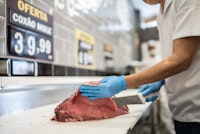

The USDA Grind Log Rule has been deemed by many as the ‘sleeping giant’ - as it was mandated in late 2015 and came into effect in June of 2016 seemingly without much fanfare. But understanding and meeting the new requirements is a concern for manufacturers and retailers that are impacted by this rule. Especially with the additional information released by the FSIS agency (Food Safety & Inspection Services) this fall on how the new requirements will be enforced.
We asked SafetyChain’s VP of FSQA, Dan Bernkopf (now retired), who had worked in quality and safety management roles in meat production facilities for more than 30 years, to provide a bit of insight on the impact of this rule and how SafetyChain is helping companies comply.
Dan, in a nutshell, what is the USDA Grind Log Rule all about?
FSIS is requiring all makers of raw ground beef to keep adequate records of the source material, so that the agency can quickly work with the source material suppliers and retail grinders to identify and recover source material associated with pathogen outbreaks. This rule represents the very first time USDA is requiring documentation at the supermarket and retail level.
Who is impacted by the USDA Grind Log Rule and what is being required?
Only ground beef is covered by the new grinding log regulations. Processes involving non-intact and mechanically-tenderizing or injecting raw beef is outside the new requirements.
FSIS amended its record keeping regulations, requiring all official establishments and retail stores who grind raw beef products, maintain the following records:
These requirements also apply to raw beef products that are ground at an individual customer’s request when new source materials are used. Grinding logs records must be maintained at the location where the raw beef is ground, and must be kept for at least one year.

How is this requirement a shift from what was documented previously?
Historically, not all supermarkets and retailers kept beef grind log records. Those that did didn’t always consistently capture records thoroughly or not in enough detail to help determine source material should a foodborne outbreak occur. USDA recognized this gap in the retail supply chain for ground beef and created this regulatory requirement as a remedy. And it supports the guiding principle of “if it’s not documented it’s not done.”
What are the key barriers to complying to this rule?
Beef grind logs seem simple but when process details are considered, the complexities of identifying and capturing the information required is more complex.
Listing all beef sources in each and every batch, as USDA requires, may include one or more log source identities for:
To document the many inputs consistently and accurately is challenging when you consider the day-to-day fast-moving and demanding retail environment.
How can SafetyChain help companies overcome these barriers and ensure USDA Grind Log Rule compliance?
SafetyChain helps companies ensure records are being completed and that they are in compliance. By utilizing mobile tablets to capture grind log data vs. the traditional pen/paper/clipboards, our customers benefit from:
With our best-in-class mobile device technology, records can be captured without an internet connection. Data is automatically synced to a centralized repository when a connection is available. Plus with records time/date stamped, it provides a higher level of record efficacy.